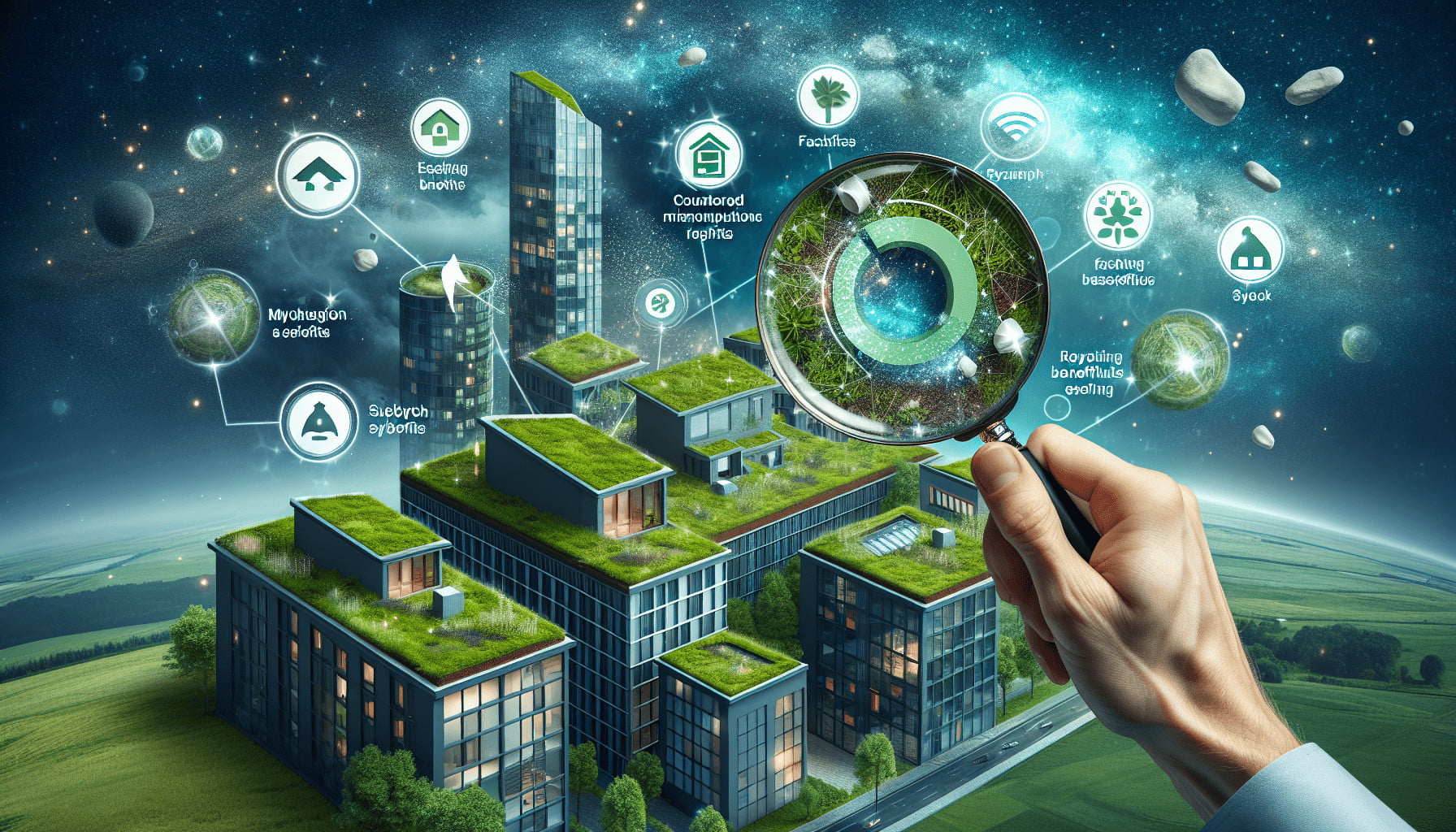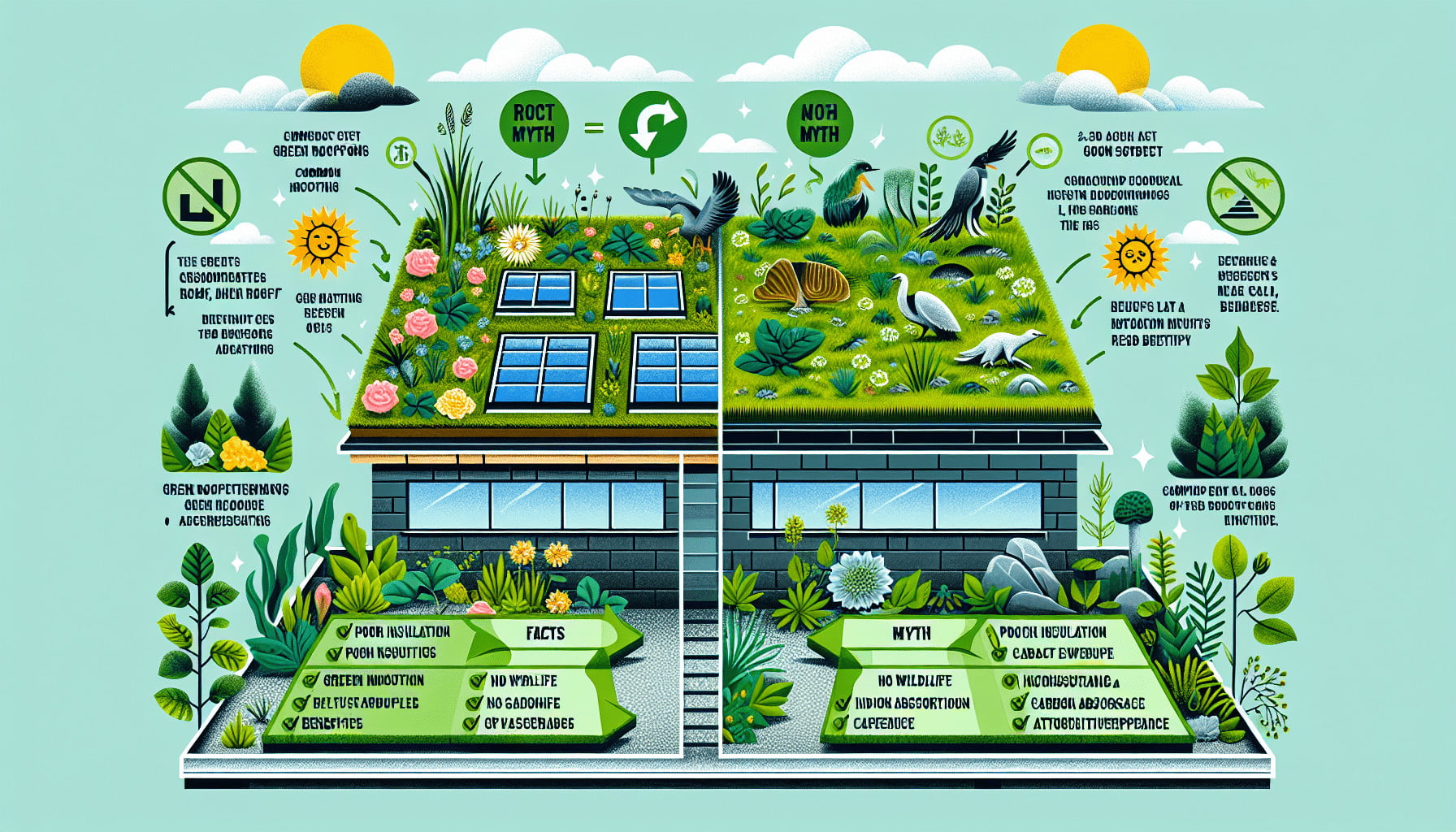Are you considering installing a green roof system but are unsure about the myths surrounding them? In this article, we debunk five common misconceptions about green roof systems to provide you with accurate information. From concerns about cost and maintenance to the belief that green roofs are only suitable for certain climates, we will shed light on these misconceptions and help you make an informed decision about incorporating a green roof system into your building. So, let’s debunk these myths and discover the truth behind green roof systems.

Myth 1: Green roofs are more prone to leaks
Explanation of the myth
One common misconception about green roofs is that they are more prone to leaks compared to traditional roofs. The belief is that the additional layers of vegetation and soil create a higher risk for water penetration. However, this myth fails to consider the advanced waterproofing and drainage systems that are integral components of green roof design.
Debunking the myth with evidence and examples
Contrary to popular belief, green roofs actually possess a superior ability to manage water compared to conventional roofs. Green roof systems are built with multiple layers of waterproof membranes and root barriers, ensuring that the underlying structure remains protected. Additionally, specialized drainage systems are integrated into green roofs to efficiently channel excess water away from the roof surface. This combination of robust waterproofing and effective drainage significantly reduces the risk of leaks.
Countless examples around the world illustrate the success of green roofs in preventing leaks. For instance, the Chicago City Hall green roof, one of the most famous green roofs in the United States, has stood for over two decades without a single leak. This achievement is a testament to the effectiveness of proper design and implementation when it comes to green roofs.
Benefits of green roofs in managing water
In addition to their ability to prevent leaks, green roofs offer numerous benefits in managing water. The vegetation on green roofs absorbs and retains rainwater, reducing the amount of runoff that would otherwise burden stormwater management systems. This natural retention helps to mitigate the risk of flash floods and erosion in urban areas.
Furthermore, green roofs act as a natural filter for rainwater, removing pollutants and impurities as the water passes through the vegetation and substrate layers. This purification process improves the overall quality of the water that eventually reaches streams, rivers, and lakes, benefiting both humans and the environment.
Myth 2: Green roofs are expensive to install and maintain
Exploring the cost factors of green roof installation
An often cited myth surrounding green roofs is that they are prohibitively expensive to install. While it is true that the initial cost of installing a green roof can be higher than that of a conventional roof, the long-term cost savings and return on investment must be considered.
The cost of green roof installation depends on various factors, including the size of the roof, the type of vegetation and substrate chosen, and the complexity of the design. However, it is essential to look beyond the initial price tag when evaluating the cost-effectiveness of green roofs.
Long-term cost savings and return on investment
Although the upfront costs may be higher, green roofs offer significant long-term cost savings. By providing an additional layer of insulation, green roofs can reduce heating and cooling costs by improving the building’s energy efficiency. This reduction in energy consumption translates into lower utility bills and a substantial return on investment over time.
Furthermore, green roofs extend the lifespan of underlying roofing materials by protecting them from UV radiation and temperature fluctuations. With proper maintenance, green roofs can last two to three times longer than conventional roofs, resulting in significant savings in roof replacement costs.
Maintenance requirements and associated costs
Another misconception is that green roofs require excessive maintenance, contributing to their overall cost. While it is true that green roofs do require some level of maintenance, it is not significantly more burdensome or costly compared to maintaining conventional roofs.
The maintenance requirements of a green roof mainly involve regular inspections, weed control, and irrigation, if necessary. Many modern green roof systems are designed with low-maintenance in mind, utilizing drought-resistant plants and automated irrigation systems. With proper planning and the use of appropriate vegetation, the maintenance costs can be minimized, making green roofs a viable option for many property owners.
Myth 3: Green roofs are only suitable for certain climates
The adaptability of green roofs to various climates
A prevalent belief is that green roofs are only suitable for specific climates, most notably those with moderate temperatures and ample rainfall. However, the truth is that green roofs can be adapted to a wide range of climatic conditions.
Through careful plant selection and appropriate design techniques, green roofs can thrive in hot and dry climates as well as in cold and snowy regions. Sedum, a drought-tolerant succulent, is a popular choice for green roofs in arid environments, while alpine plants are commonly used in regions with colder climates.
Case studies of successful green roofs in different regions
Numerous case studies from around the world demonstrate the successful implementation of green roofs in diverse climates. For example, the Bosco Verticale in Milan, Italy, is a pair of residential towers with over 20,000 plants that thrive in the city’s hot summers and cold winters. The project showcases the adaptability of green roofs to extreme temperature variations.
Similarly, the Mountain Equipment Co-op Headquarters in Vancouver, Canada, features a green roof that withstands heavy rainfall and frequent snowfall. This example highlights the applicability of green roofs in regions with abundant precipitation.
Innovative techniques for adapting green roofs to extreme climates
As the demand for green roofs in various climates continues to grow, innovative techniques are being developed to enhance their adaptability. These include the use of advanced irrigation systems, selection of specific plant species, and implementation of additional insulation layers to protect against extreme temperatures.
Research and development in the field of green roof technology are continually advancing, ensuring that green roofs can thrive and provide benefits in any climate, from the hottest deserts to the coldest tundras.
Myth 4: Green roofs are difficult to access and use
Design considerations for accessible green roofs
A common misconception is that green roofs are inaccessible and unusable spaces. However, with careful design considerations, green roofs can be made accessible to occupants and visitors, creating valuable outdoor spaces.
To make green roofs accessible, architects and designers incorporate features such as staircases, ramps, and elevators into the building’s design. Additionally, walkways and gathering areas are integrated into the layout, offering people the opportunity to enjoy the green space comfortably.
Benefits of accessible green roofs
Accessible green roofs provide numerous benefits, both for individuals and communities. These rooftop green spaces offer opportunities for relaxation, exercise, and socialization, promoting overall well-being. People can escape the concrete jungle and connect with nature without leaving the building.
Moreover, accessible green roofs contribute to urban biodiversity by providing habitats for birds, butterflies, and other wildlife. They also help reduce the urban heat island effect by absorbing heat and cooling the surrounding environment.
Examples of successful accessible green roof projects
Across the globe, many successful green roof projects have embraced accessibility and usability. The High Line in New York City, for instance, is a prime example of a green roof turned public park. Built upon an elevated railway track, it offers pedestrians a unique urban oasis with picturesque views of the cityscape.
Another noteworthy project is the Kensington Roof Gardens in London, UK. This stunning green roof incorporates ornamental gardens, walking paths, and even a restaurant, creating a multi-functional space that attracts visitors from all walks of life.

Myth 5: Green roofs attract pests and require excessive maintenance
Common concerns about pests and maintenance
Some individuals believe that green roofs attract pests, including insects, birds, and rodents, which can lead to increased maintenance and potential health risks. However, these concerns are largely unfounded when proper design and maintenance practices are followed.
While it is true that green roofs can attract wildlife, such as birds and insects, the presence of these creatures is not necessarily a negative aspect. In fact, many green roof projects actively encourage biodiversity, as these animals contribute to a healthy ecosystem.
Integrated pest management strategies for green roofs
Integrated Pest Management (IPM) strategies can effectively address any potential pest issues on green roofs. IPM focuses on preventive measures, such as selection of pest-resistant plant species and regular inspections, to avoid the use of harmful chemicals. When pests do arise, IPM promotes the use of environmentally friendly pest control methods, minimizing the impact on the environment and human health.
By implementing IPM strategies, green roofs can strike a balance between biodiversity and maintenance, ensuring a harmonious coexistence with nature.
Efficient maintenance practices for green roofs
Contrary to the common belief that green roofs require excessive maintenance, efficient practices can reduce the time and effort invested in their upkeep. Regular inspections, particularly during the initial phases of a green roof’s life, allow for the early detection of any issues and the prompt implementation of necessary maintenance measures.
Additionally, modern green roof designs often include automated irrigation systems, reducing the need for manual watering. The careful selection of plants that are well-suited to the local climate can minimize the need for pest control, pruning, and fertilization.
By employing thoughtful design and embracing innovative maintenance practices, the upkeep of green roofs can be streamlined, making them a viable and practical option for both residential and commercial buildings.
In conclusion, green roofs continue to be plagued by various myths that undermine their potential benefits. However, through careful examination and evidence-based explanations, these myths can be debunked. Green roofs are proven to be effective in managing water, provide long-term cost savings, are adaptable to various climates, can be made accessible and usable, and require efficient maintenance practices. By dispelling these myths, individuals and communities can make informed decisions regarding the implementation of green roof systems, contributing to a more sustainable and resilient built environment.
